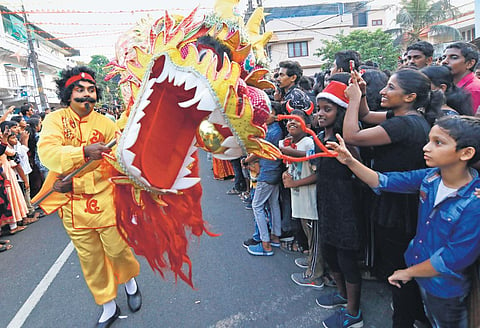

KOCHI: It’s that time of the year. Fort Kochi is decked up to welcome people from all over the world for the Cochin Carnival. The origins of the carnival go way back — to the 16th century — when the area was a Portuguese colony.
“It’s the Europeans who started celebrating New Year on January 1,” says Robert Stephen, who is part of the organising team of Cochin Carnival. “The Portuguese introduced the annual tradition of year-end galas to the island city. And the locals kept up the custom as the Vasco da Gama Square in Fort Kochi became synonymous with the carnival,” he recounts.
“Local residents have been celebrating the New Year with their families for centuries,” says Robert. “Clubs turned it into a grand celebration a few decades ago. They started marking the end of the year with the burning of Pappanji. And then, the United Nations designated 1985 as the ‘International Youth Year’. It all began when some local youths decided to be part of the global celebration,” he notes. Inspired by the UN announcement, three youngsters — George Augustine Thundiparambil, Ananda Felix Scaria and Antony Anup Scaria — decided to organise a beach festival with the slogan ‘Adventure and Environment’.
On the lines of the New Year celebrations of the Portuguese, they shaped the festivities into a significant cultural event and called it Carnivale Cochin. Over time, the event came to be known as Cochin Carnival with people from around the world congregating at Parade Ground to witness the burning of Pappanji and usher in the New Year.
Recently, a 27-year-old Fort Kochi native published a book tracing the roots of the celebration, in what is the first literature on the subject. The book — The Cochin Carnival Unveiled — is a result of Neha Agnes Francis’ lifelong fascination with the carnival.
Tracing the 40-year history of Carnival
As a child, Neha used to watch the festivities from her father’s shoulders. She was captivated. The decorated streets, illuminations, and year-end parade stirred up images of fantasy land. She decided to base her PG thesis on the carnivalesque theory and its application to the cultural significance of the Cochin Carnival. Reflecting on her research, completed in 2019, Neha says, “When I was exploring the Cochin Carnival, I struggled with lack of literature on the subject.
There was no book dedicated to this 40-year-old cultural phenomenon. When my research mentor suggested turning my project into a book, I didn’t hesitate.” Neha gathered the data by engaging with local people, emphasising that, unlike many festivals in the country, the Cochin Carnival is a truly secular event.
She dispels the misconception that the carnival is merely about the burning of Pappanji, asserting that each competition and event holds cultural significance. The parade, in particular, reflects societal progress, with increased participation from the transgender community, Neha added.
The carnival itself begins on the first Sunday of December with the traditional peace and solidarity ceremony involving veterans, the Navy and the local people near St Francis Church. The festival continues throughout the month, picking up steam in the final week.